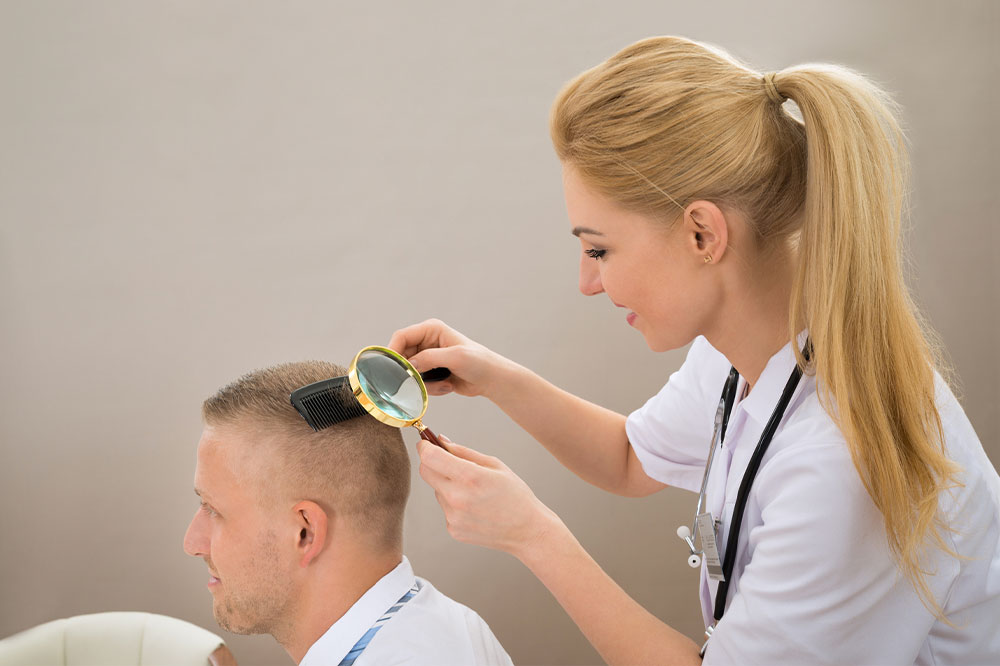
Head lice – Symptoms, causes, and management
Lice are small, wingless insects that can live on the scalp and feed on human blood. Although they are not harmful, they may cause itching and scalp irritation. The risk of head lice is highest among preschoolers and elementary school children, as they frequently engage in close play. So, to prevent the spread of lice, one should try to get rid of the pests as soon as they notice any symptoms of an infestation.
Symptoms
Intense itching is the most typical sign of head lice; however, here are a few other signs that can indicate an infestation:
Visible lice or nits: One can observe lice about the size of sesame seeds crawling on the scalp or hair. Small, oval-shaped nits, also known as lice eggs, typically stick to the hair shaft close to the scalp.
Red bumps or sores on the scalp: Itching can cause small, red pimples or sores that could increase the risk of infection.
Sleeping issues and irritability: The persistent itching and pain can make it difficult to sleep or focus, resulting in one becoming irritable.
Tingling sensation on the scalp: Some may experience a tingling sensation on their scalp as the lice crawl on the head.
Lice on clothing or bedding: Lice may be observed on clothing, bedding, or other personal belongings as they can survive off the scalp for up to two days.
Causes
Children crammed together in childcare centers and elementary schools are frequently the most vulnerable to a head lice infestation. As lice do not have wings, they cannot leap or fly from one person to another. So, they move by quickly crawling or gripping a strand of hair with their tiny front claws and swinging from one strand to the next. So, when kids play with their heads close together, the infestation spreads directly from head to head or indirectly through sharing hats, coat hooks, scarves, bicycle helmets, headsets, hairbrushes, toys, or bedding.
Treatment options
Treatment for head lice might require multiple applications to completely eliminate adult lice and eggs. Here are the common options one can try:
Anti-lice shampoos, cream rinses, and lotions: Often, the effectiveness of lice shampoo or lotion in killing or targetting lice varies depending on the ingredients and amount of application. To ensure that no new lice have emerged from the nits, most treatments should be repeated in 7 to 10 days. One should consult a doctor for detailed instructions on how to use these products and for advice on the best courses of action based on the age of the patient and the type of infestation. These prescription and non-prescription shampoos and ointments can help kill most adult lice on the scalp.
Use tweezers or a fine comb: Once the adult lice are removed, the last few nits can be removed using tweezers or a fine comb. Depending on the length of the hair and the number of nits, this may take several hours. In addition to the person affected, people close to them should also check their scalp for nits and lice and see if they require treatment. It is important to check for head lice every few days when undergoing treatment.
Prevention
Here are some tips for preventing head lice:
– It is important to report any head itching and not share hats, headphones, combs, brushes, or bicycle helmets with others.
– Long hair should be pulled back and kept off the face.
– One should regularly inspect their children’s hair, especially if they scratch their heads a lot.
– Hats, towels, and pillows should all be washed in hot water (over 55°C or 130°F) and dried in a hot dryer for about 30 minutes if one has been in close proximity to someone with head lice.
– Non-washable items like pillows can be dry cleaned or placed in airtight plastic bags for 14 days to kill lice, as they cannot survive for long outside human contact.
– All brushes and combs should be washed in a lice removal shampoo or soaked in hot water for 5 to 10 minutes.
– One should vacuum all surfaces, including rugs, car seats, furniture, beds, and pillows that may have been used as a headrest.
– Parents should not delay informing school authorities that their children have lice, as doing so is crucial for stopping the spread of these pests. If head lice symptoms are observed, parents should notify everyone who may have come into contact with the child.
With the right treatment options, head lice can be completely removed. One might, however, get lice in the future if exposed to an infestation. One can lower that risk by keeping the home clean and avoiding close contact with anyone who has head lice. One should also practice good hygiene to lower the risk of head lice.




